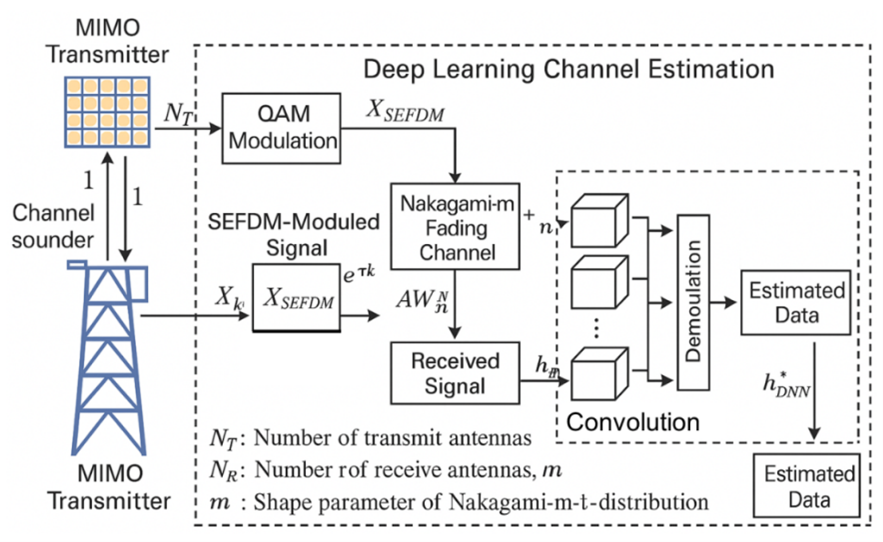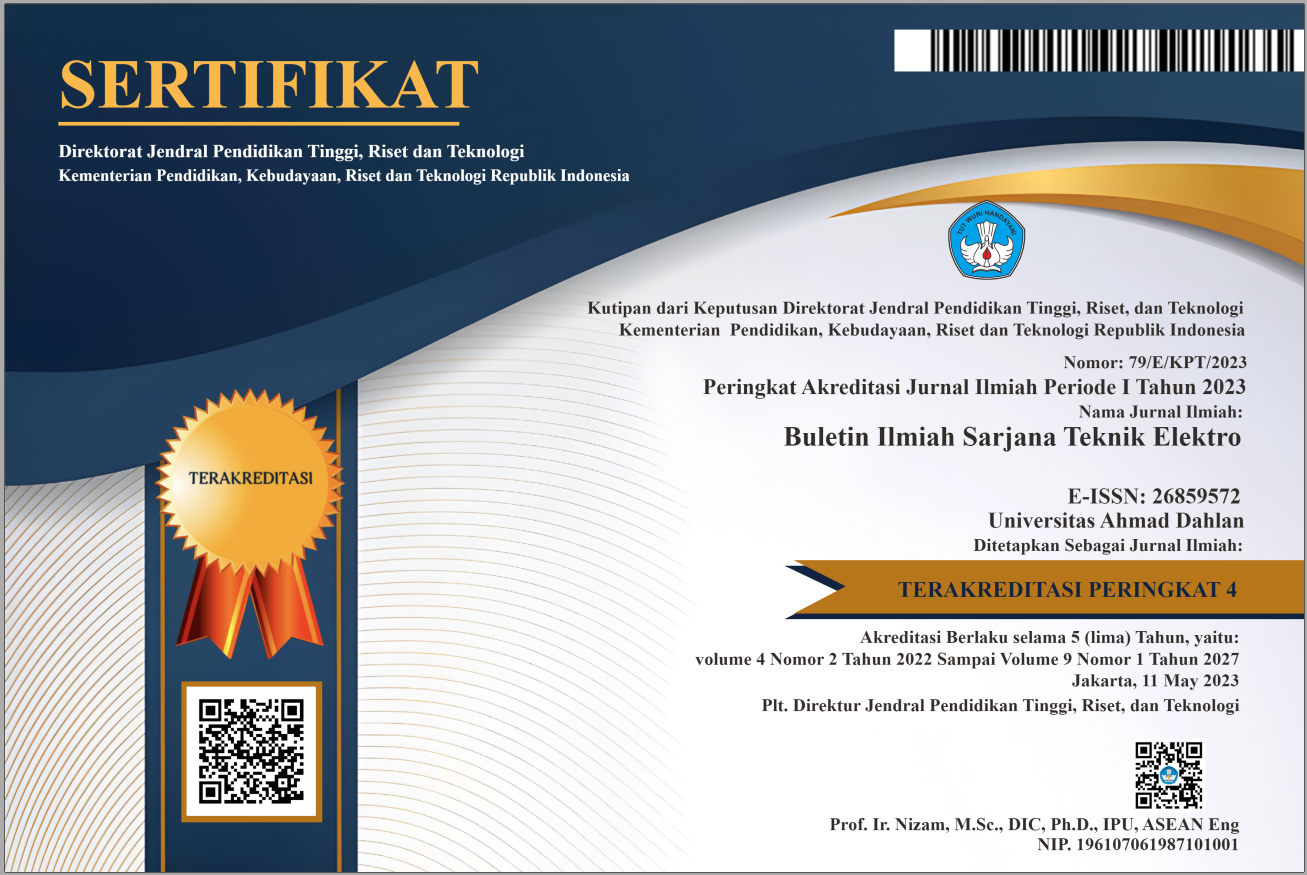Enhancement of Channel Estimation in Spectrally Efficient Frequency Division Multiplexing-based Massive MIMO Systems for 5G NR and Beyond: A Comparative Analysis of LSE, MMSE, and Deep Neural Network Architectures
DOI:
https://doi.org/10.12928/biste.v7i2.13058Keywords:
Channel Estimation, 5G NR, SEFDM, MMSE, Deep LearningAbstract
Channel estimation is a significant challenge in 5G NR and future communication systems because of complicated propagation settings, including high-order modulation and Nakagami-m fading. High spectral efficiency is necessary to satisfy increasing data demands. To improve channel prediction in a 32×32 Massive MIMO architecture, this study suggests a unified framework that combines Deep Neural Networks (DNN), compressed pilot signals, and Spectrally Efficient Frequency Division Multiplexing (SEFDM). The system utilizes SNR as an input characteristic for the deep learning model and 256-QAM modulation. With average MSE (Mean Square Error) values of 1.2776 for LSE (Lest Square Estimation ) and 1.055 for MMSE (Minimum Mean Square Error ), simulation findings show that traditional estimators like LSE and MMSE perform well in moderate-SNR settings. The average MSE of 0.498 obtained by the DNN-based estimator is much lower and best. The model's advantage in capturing nonlinear channel features is shown by graphical comparisons of real vs. anticipated channel gains, leading to better reliability and throughput. In summary, the DNN model exhibits exceptional performance and versatility for real-time channel prediction in spectrally efficient next-generation communication systems, e.g., IoT, autonomous systems.
References
M. Ahmad, M. S. Sarwar, and S. Y. Shin, “Deep Learning Assisted Channel Estimation for Adaptive Parameter Selection in mMIMO-SEFDM,” IEEE Internet Things J., pp. 1–1, 2025, https://doi.org/10.1109/JIOT.2025.3554763.
C. Dai, S. Xiang, L. Xie, S. Garg, G. Kaddoum, and M. M. Hassan, “An Improved Nonlinear Precoding Scheme in Multicarrier Signaling Optimization for Transportation Networks Applications,” IEEE Trans. Intell. Transp. Syst., pp. 1–9, 2025, https://doi.org/10.1109/TITS.2025.3531663.
X. Wang, Y. Zhao, and Z. Huang, “A Survey of Deep Transfer Learning in Automatic Modulation Classification,” IEEE Trans. Cogn. Commun. Netw., pp. 1–1, 2025, https://doi.org/10.1109/TCCN.2025.3558027.
Y. Y. U. Ongyi et al., “High spectral efficiency modulation scheme based on joint interaction of orthogonal compressed chirp division multiplexing and power superimposed code,” Optics Express, vol. 32, no. 6, pp.9671-9685, 2024, https://doi.org/10.1364/OE.514839.
M. Ahmad, M. Sarwar, S. Shin, “Enhancing mMIMO-SEFDM System through Deep Learning-Based Channel Estimation and Adaptive Parameter Selection,” Authorea Preprints, 2024, https://doi.org/10.36227/techrxiv.172262850.03634715/v1.
A. Tariq, M. Sajid Sarwar and S. Y. Shin, "Orthogonal Time-Frequency–Space Multiple Access Using Index Modulation and NOMA," in IEEE Wireless Communications Letters, vol. 14, no. 5, pp. 1456-1460, 2025, https://doi.org/10.1109/LWC.2025.3544234.
L. Xiang, K. Xu, J. Hu, C. Masouros and K. Yang, "Robust NOMA-Assisted OTFS-ISAC Network Design With 3-D Motion Prediction Topology," in IEEE Internet of Things Journal, vol. 11, no. 9, pp. 15909-15918, 1 May1, 2024, https://doi.org/10.1109/JIOT.2024.3352391.
W. Chen, J. Tao, L. Ma and G. Qiao, "Vector-Approximate-Message-Passing-Based Channel Estimation for MIMO-OFDM Underwater Acoustic Communications," in IEEE Journal of Oceanic Engineering, vol. 49, no. 2, pp. 496-506, April 2024, https://doi.org/10.1109/JOE.2023.3337349.
V. N. Senthil Kumaran, R. Guttula, and G. N. Reddy, “Hybrid Optimized LMMSE-Based Channel Estimation with Low Power Trellis Coded Modulation,” Cybernetics and Systems, pp. 1-23, 2024. https://doi.org/10.1080/01969722.2024.2343989.
S. Khichar, W. Santipach, L. Wuttisittikulkij, A. Parnianifard, and S. Chaudhary, “Efficient Channel Estimation in OFDM Systems Using a Fast Super-Resolution CNN Model,” J. Sens. Actuator Networks, vol. 13, no. 5, p. 55, 2024, https://doi.org/10.3390/jsan13050055.
S. Kanwal and S. Jiriwibhakorn, “Advanced Fault Detection, Classification, and Localization in Transmission Lines: A Comparative Study of ANFIS, Neural Networks, and Hybrid Methods,” IEEE Access, vol. 12, pp. 49017–49033, 2024, https://doi.org/10.1109/ACCESS.2024.3384761.
E. Fola, Y. Luo, and C. Luo, “AE-DENet: Enhancement for Deep Learning-based Channel Estimation in OFDM Systems,” in GLOBECOM 2024 - 2024 IEEE Global Communications Conference, IEEE, pp. 1449–1454, 2024, https://doi.org/10.1109/GLOBECOM52923.2024.10901113.
R. Martínez, F. E. López Giraldo, J. M. Luna Rivera, J. D. Navarro Restrepo, and J. D. Rojas Usuga, “Evaluation of Solar Panel Bandwidth for RGB Channels in Visible Light Communication,” IEEE Lat. Am. Trans., vol. 22, no. 3, pp. 240–248, 2024, https://doi.org/10.1109/TLA.2024.10431426.
H. Alraie, R. Alahmad, and K. Ishii, “Double the data rate in underwater acoustic communication using OFDM based on subcarrier power modulation,” J. Mar. Sci. Technol., vol. 29, no. 2, pp. 457–470, 2024, https://doi.org/10.1007/s00773-024-00989-2.
N. Almaymoni, O. Alkhazragi, W. H. Gunawan, G. Melinte, T. K. Ng, and B. S. Ooi, “High-Speed 645-nm VCSELs for Low-Scattering-Loss Gb/s Underwater Wireless Optical Communications,” IEEE Photonics Technol. Lett., vol. 36, no. 6, pp. 377–380, 2024, https://doi.org/10.1109/LPT.2024.3360229.
Y. Qi, T. Zhang, Y. Feng, Z. Qin and D. He, "Design and Implementation of Spectrally Efficient Frequency Division Multiplexing Receiver," in IEEE Access, vol. 11, pp. 121482-121491, 2023, https://doi.org/10.1109/ACCESS.2023.3328234.
Y. Hama and H. Ochiai, "On the Achievable Spectral Efficiency of Non-Orthogonal Frequency Division Multiplexing," in IEEE Transactions on Communications, vol. 71, no. 11, pp. 6246-6257, 2023, https://doi.org/10.1109/TCOMM.2023.3300328.
X. Liu. Spectrally and Energy Efficient Wireless Communications: Signal and System Design, Mathematical Modelling and Optimisation (Doctoral dissertation, UCL (University College London)). 2023. https://discovery.ucl.ac.uk/id/eprint/10176195.
R. Mani, A. Rios-Navarro, J.-L. Sevillano-Ramos, and N. Liouane, “Improved 3D localization algorithm for large scale wireless sensor networks,” Wirel. Networks, vol. 30, no. 6, pp. 5503-5518, 2023, https://doi.org/10.1007/s11276-023-03265-0.
E. H. Kadhim and A. T. Abdulsadda, “Improving the Size of the Propellers of the Parrot Mini-Drone and an Impact Study on its Flight Controller System,” Int. J. Robot. Control Syst., vol. 3, no. 2, pp. 171–186, 2023, https://doi.org/10.31763/ijrcs.v3i2.933.
J. Shi et al., “Neural Network Equalizer in Visible Light Communication: State of the Art and Future Trends,” Front. Commun. Networks, vol. 3, no. April, pp. 1–11, 2022, https://doi.org/10.3389/frcmn.2022.824593.
X. Hou et al., “Non-Orthogonal Physical Layer (NOPHY) Design towards 5G Evolution and 6G,” IEICE Trans. Commun., vol. E105B, no. 11, pp. 1444–1457, 2022, https://doi.org/10.1587/transcom.2021EBP3192.
X. Liang, H. Niu, and B. Cai, “Blind CFO Estimator for Spectrally Efficient Frequency Division Multiplexing System,” IEEE Photonics Technol. Lett., vol. 34, no. 1, pp. 59–62, 2022, https://doi.org/10.1109/LPT.2021.3137329.
X. Liang, H. Niu, A. Liu, Z. Gao, and Y. Zhang, “Joint STO and DFO Estimation for SEFDM in Low-Earth-Orbit Satellite Communications,” IEEE Trans. Aerosp. Electron. Syst., vol. 58, no. 4, pp. 3725–3729, 2022, https://doi.org/10.1109/TAES.2021.3140186.
H. J. Park, S. -M. Kang, I. Ha and S. -K. Han, "Hexagonal QAM-Based Four-Dimensional AMO-OFDM for Spectrally Efficient Optical Access Network Transmission," in IEEE Access, vol. 7, pp. 176814-176819, 2019. https://doi.org/10.1109/ACCESS.2019.2957844.
X. Liang, A. Liu, B. Cai, S. Peng, and C. Han, “Low-Complexity CFO Estimator for Spectrally Efficient Frequency Division Multiplexing System,” IEEE Trans. Veh. Technol., vol. 71, no. 6, pp. 6762–6766, 2022, https://doi.org/10.1109/TVT.2022.3161668.
S. Stainton, M. Johnston, S. Dlay, and P. A. Haigh, “Evm loss: A loss function for training neural networks in communication systems,” Sensors (Switzerland), vol. 21, no. 4, pp. 1–9, 2021, https://doi.org/10.3390/s21041094.
N. H. Nguyen, H. H. Nguyen and B. Berscheid, "SVD-Based Design for Non-Orthogonal Frequency Division Multiplexing," in IEEE Communications Letters, vol. 25, no. 4, pp. 1343-1347, 2021, https://doi.org/10.1109/LCOMM.2020.3045719.
E. H. Kadhim and A. T. Abdulsadda, “The flight management system in parrot mini-drone,” AIP Conf. Proc., vol. 2776, no. 1, p. 40008, 2023, https://doi.org/10.1063/5.0137270.
E. Zimaglia, D. G. Riviello, R. Garello, and R. Fantini, “A Deep Learning-based Approach to 5G-New Radio Channel Estimation,” in 2021 Joint European Conference on Networks and Communications & 6G Summit (EuCNC/6G Summit), IEEE, pp. 78–83, 2021, https://doi.org/10.1109/EuCNC/6GSummit51104.2021.9482426.
H. Ghannam, D. Nopchinda, M. Gavell, H. Zirath and I. Darwazeh, "Experimental Demonstration of Spectrally Efficient Frequency Division Multiplexing Transmissions at E-Band," in IEEE Transactions on Microwave Theory and Techniques, vol. 67, no. 5, pp. 1911-1923, May 2019, https://doi.org/10.1109/TMTT.2019.2901667.
S. Osaki, M. Nakao, T. Ishihara, and S. Sugiura, “Differentially Modulated Spectrally Efficient Frequency-Division Multiplexing,” IEEE Signal Process. Lett., vol. 26, no. 7, pp. 1046–1050, 2019, https://doi.org/10.1109/LSP.2019.2918688.
D. Vasilyev and A. Rashich, "SEFDM-signals Euclidean Distance Analysis," 2018 IEEE International Conference on Electrical Engineering and Photonics (EExPolytech), pp. 75-78, 2018, https://doi.org/10.1109/EExPolytech.2018.8564439.
H. Ye, G. Y. Li and B. -H. Juang, "Power of Deep Learning for Channel Estimation and Signal Detection in OFDM Systems," in IEEE Wireless Communications Letters, vol. 7, no. 1, pp. 114-117, Feb. 2018, https://doi.org/10.1109/LWC.2017.2757490.
M. Jia, Z. Yin, Q. Guo, G. Liu and X. Gu, "Waveform Design of Zero Head DFT Spread Spectral Efficient Frequency Division Multiplexing," in IEEE Access, vol. 5, pp. 16944-16952, 2017, https://doi.org/10.1109/ACCESS.2017.2740267.
T. Xu and I. Darwazeh, “A Joint Waveform and Precoding Design for Non-Orthogonal Multicarrier Signals,” in 2017 IEEE Wireless Communications and Networking Conference (WCNC), IEEE, pp. 1–6, 2017, https://doi.org/10.1109/WCNC.2017.7925796.
J. Huang, Q. Sui, Z. Li and F. Ji, "Experimental Demonstration of 16-QAM DD-SEFDM With Cascaded BPSK Iterative Detection," in IEEE Photonics Journal, vol. 8, no. 3, pp. 1-9, 2016, https://doi.org/10.1109/JPHOT.2016.2552480.
N. Wu, Y. Ma, and R. Jiang, “Message Passing Receiver for SEFDM Signaling Over Multipath Channels,” in Advanced Receiver Design for Multicarrier FTN Signaling in 6G Systems, pp. 29–42, 2025, https://doi.org/10.1007/978-981-96-0730-3_2.
N. Wu, Y. Ma, and R. Jiang, “Joint Channel Estimation and Equalization for Index-Modulated SEFDM Signaling,” in Advanced Receiver Design for Multicarrier FTN Signaling in 6G Systems, pp. 43–72, 2025, https://doi.org/10.1007/978-981-96-0730-3_3.
C.-K. Wen, W.-T. Shih, and S. Jin, “Deep Learning for Massive MIMO CSI Feedback,” IEEE Wirel. Commun. Lett., vol. 7, no. 5, pp. 748–751, 2018, https://doi.org/10.1109/LWC.2018.2818160.

Published
How to Cite
Issue
Section
License
Copyright (c) 2025 Esraa Hadi Kadhim, Ahmad T. Abdulsadda Abdulsadda

This work is licensed under a Creative Commons Attribution-ShareAlike 4.0 International License.
Authors who publish with this journal agree to the following terms:
- Authors retain copyright and grant the journal right of first publication with the work simultaneously licensed under a Creative Commons Attribution License that allows others to share the work with an acknowledgment of the work's authorship and initial publication in this journal.
- Authors are able to enter into separate, additional contractual arrangements for the non-exclusive distribution of the journal's published version of the work (e.g., post it to an institutional repository or publish it in a book), with an acknowledgment of its initial publication in this journal.
- Authors are permitted and encouraged to post their work online (e.g., in institutional repositories or on their website) prior to and during the submission process, as it can lead to productive exchanges, as well as earlier and greater citation of published work (See The Effect of Open Access).
This journal is licensed under a Creative Commons Attribution-ShareAlike 4.0 International License.


